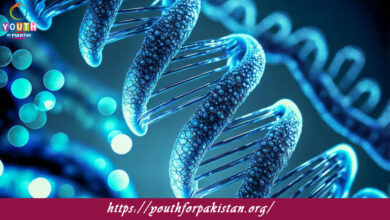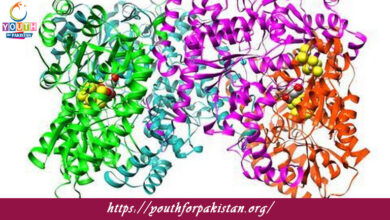Welcome to the Nucleic Acids MCQs with Answers, it helps learners quickly identify areas for improvement in Nucleic Acids Online Test.
| Nucleic acids are essential biomolecules that store and transmit genetic information in living organisms. They are composed of nucleotide monomers, each consisting of a phosphate group, a pentose sugar (ribose in RNA or deoxyribose in DNA), and a nitrogenous base (adenine, guanine, cytosine, thymine in DNA, and uracil in RNA). The sequence of these nitrogenous bases along the nucleic acid strand determines the genetic code and plays a crucial role in protein synthesis and cellular function.
DNA (deoxyribonucleic acid) is double-stranded and forms a double helix structure, while RNA (ribonucleic acid) is usually single-stranded. DNA stores genetic information and undergoes replication to pass this information to daughter cells during cell division. RNA, on the other hand, acts as a messenger carrying genetic instructions from DNA to guide protein synthesis.
In MCQs on nucleic acids, students are tested on various aspects such as the structure and function of DNA and RNA, the differences between them, the base pairing rules, the role of nucleic acids in genetic inheritance, and their involvement in cellular processes like transcription and translation. Understanding nucleic acids is crucial in fields like genetics, molecular biology, biotechnology, and medicine, as it provides insights into how genetic information is encoded, expressed, and inherited across generations. These MCQs help students grasp these fundamental concepts and prepare effectively for exams and assessments in related disciplines. |
Nucleic Acids Online Quiz
By presenting 3 options to choose from, Nucleic Acids Quiz which cover a wide range of topics and levels of difficulty, making them adaptable to various learning objectives and preferences. You will have to read all the given answers of Nucleic Acids Questions and Answers and click over the correct answer.
- Test Name: Nucleic Acids MCQ Quiz Practice
- Type: Quiz Test
- Total Questions: 40
- Total Marks: 40
- Time: 40 minutes
Note: Answer of the questions will change randomly each time you start the test. Practice each quiz test at least 3 times if you want to secure High Marks. Once you are finished, click the View Results button. If any answer looks wrong to you in Quiz, simply click on question and comment below that question, so that we can update the answer in the quiz section.
Download Certificate of Nucleic Acids Test
On the end of Quiz, you can download the certificate of the quiz if you got more than 70% marks.
Nucleic Acids Flashcards

What are the building blocks of nucleic acids?

Which of the following is NOT a component of a nucleotide?

Which of the following nitrogenous bases is found in RNA but not in DNA?

What is the sugar component of RNA nucleotides?

How many types of nucleotides are found in DNA?

Which of the following nitrogenous bases pairs with adenine in DNA?

What type of bond holds the nitrogenous bases together in the DNA double helix?

Which scientist(s) is/are credited with discovering the structure of DNA?

What is the shape of the DNA molecule?

What is the function of DNA in the cell?
Genetic information storage

Which enzyme is responsible for unwinding the DNA double helix during replication?

What is the role of DNA polymerase during DNA replication?
Synthesizes new DNA strands

Which of the following describes the directionality of DNA replication?

What is the name of the process by which RNA is synthesized from a DNA template?

What is the function of mRNA in protein synthesis?
Carries genetic information from DNA to ribosomes

Where does mRNA bind during translation?

Which of the following is NOT a type of RNA involved in protein synthesis?

What is the function of tRNA in protein synthesis?
Carries amino acids to ribosomes

What is the role of ribosomes in protein synthesis?
Site of protein synthesis

What is the function of rRNA in protein synthesis?
Forms part of the ribosome structure

Which of the following represents the central dogma of molecular biology?

Which nucleic acid serves as the genetic material in most organisms?

Which of the following is NOT a type of DNA mutation?

What is the consequence of a frameshift mutation?
Alters the reading frame of the genetic code

Which type of mutation results in the substitution of one nucleotide for another?

What is the consequence of a silent mutation?
No change in the amino acid sequence

What is the name of the process by which RNA is converted into a protein?

Which of the following is NOT a stop codon in the genetic code?

What is the function of the genetic code?
Specifies the amino acid sequence of proteins

How many nucleotides are required to code for one amino acid in the genetic code?

Which of the following represents a codon in the genetic code?

Which of the following is a start codon in the genetic code?

What is the role of the start codon in protein synthesis?

What is the significance of the genetic code being degenerate?
Multiple codons can code for the same amino acid

Which of the following is a function of microRNAs (miRNAs) in gene regulation?
Post-transcriptional gene silencing

Which of the following processes involves the degradation of mRNA molecules?

What is the enzyme responsible for adding nucleotides to the growing RNA chain during transcription?

What is the function of DNA ligase in DNA replication?
Joins Okazaki fragments on the lagging strand

Which of the following represents the complementary base pairing in DNA?
Adenine-Thymine, Guanine-Cytosine

Which of the following is a characteristic feature of RNA molecules?
If you are interested to enhance your knowledge regarding Physics, Computer, and Biology please click on the link of each category, you will be redirected to dedicated website for each category.






